Archaeological Excavations 2005
Archaeological Excavations 2005
The Millersville University excavations conducted during 2005 at Elizabeth Furnace represent the first archaeological research undertaken at this site. Because the core area of the property contains roughly six acres of densely-packed colonial and later period settlement and associated archaeological sites, a thorough archaeological investigation and survey of the property will necessarily be a long-term process.
Our initial research focused on testing and excavation around the John Huber house (ca. 1746). Testing during the summer of 2005 indicated that much of the area north, west, and south of the Huber house had been disturbed, most likely by grading activity conducted sometime during the early to mid- 20th century. Intact stratigraphy dating back to the 18th-century was found to exist on the east side of the house. Additionally, a large stone-lined furnace race (a man-made stream constructed to carry water to power the bellows of the furnace) was found directly off the north-west corner of the house. Large-scale block excavations were conducted in these areas during the Fall of 2005, revealing all of the underlying stratigraphy and features in these areas.
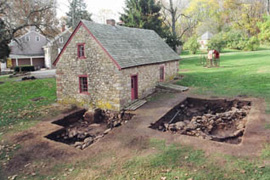 |
| The excavations around the Huber house revealed the furnace race channel. The furnace race's base is approximately 4ft. below |
The Huber house is a classic central-Pennsylvania German vernacular house. Measuring 18 by 38 feet, the asymmetrical windows and doors mirror the interior room layout, which is the standard 3-room "Kitchen - Stove room - Chamber bedroom" Germanic small-house plan. Significant discoveries resulted from these initial excavations. The furnace race was found to extend nearly 4 feet below the present ground
The excavations clearly revealed the channel of the furnace race, bounded on the downslope side by a large dry-laid stone wall, and on the uphill side by a more ephemeral stone lining. The stones lining both sides were there presumably to prevent erosion during times of high-volume water flow in the channel. Surprisingly, at its nearest point, the upper wall of the furnace race was built less than two feet from the foundation of the Huber House.
The initial excavations have produced more than 23,500 individual artifacts all of which have been cleaned, stabilized if necessary, and
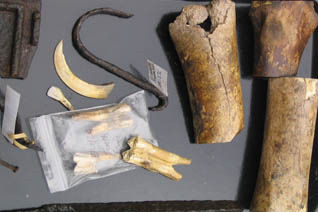 |
| The excavations around the Huber house revealed the furnace race channel. The base of the channel is approximately 4ft. below |
Numerous metal artifacts including many pieces cast at the furnace, such as these fragments of stove plates, were found. Faunal remains consisted almost exclusively of cow and pig bones and teeth. One particularly interesting artifact was a loaf of lead found in the furnace race. Small pieces were removed from the loaf in order to cast lead shot individually for muzzle-loading weapons, usually around a campfire or hearth, and this example shows clear evidence of the hack-marks and cuts of previously removed pieces.
Other artifacts included numerous pieces of creamware and pearlware, including several specimens that could be cross-mended into nearly complete vessels. Hand-blown bottle glass with pontil marks, a black basalt teapot, and pipe-stems and bowls were typical. For more on artifacts from this excavation (Click Here)...
The artifacts indicate that the primarily German immigrants, who were working and managing the furnace during the first 25 years of its operation, utilized English and American manufactured material culture in their daily lives. Every piece of ceramic recovered thus far was of English or American manufacture. Not a single piece of German stoneware, for example, was present in this artifact assemblage, an interesting fact given the ethnicity of the occupants. Additionally, transport or local availability does not appear to be an issue, as Germanic-manufactured materials, particularly Westerwald Stonewares, were found during excavation at nearby Ephrata Cloister as well as other contemporary sites in Colonial Pennsylvania at this time.
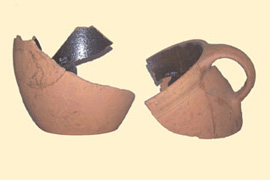 |
| This is one of the many chamber pots discovered in the furnace race. The fact that many of the chamber pots are nearly complete or broken in large pieces, suggests that they broke as they were dropped or thrown in the furnace race. This suggests that the furnace race was being used for human waste disposal. |
Additionally, there appears to be strong evidence of human waste being
In terms of refuse disposal, trash produced by the occupants of the Huber house was disposed of on the grounds surrounding the building, appearing to cluster outside windows and doors in the common pattern. Several small trash pits showing deliberate disposal of items were found within five to ten feet of the exterior walls of the building.
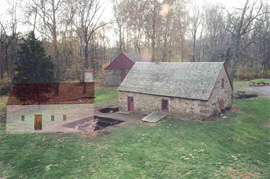 |
| The above is |
Excavations also revealed the unexpected discovery of the foundation trenches of a building and an associated fireplace hearth directly adjacent to the furnace race. The location produced a strong domestic artifact scatter including window glass and numerous ceramic fragments, as well as charcoal flecking in the soil. It appears this was a wood-framed building with a large stone
The layout of the landscape, including the discovery of the location of the furnace race and an associated building foundation adjacent to it, display clear evidence of a work life and built environment ordered around Germanic, as opposed to English, practice. Unlike settlers of English descent, who tend to locate buildings and activity areas away from water, a significant number of buildings at Elizabeth Furnace were deliberately sited directly on or adjacent to the furnace race.
A total of five buildings, including the charcoal house, stables, a domestic or craft house, and two dwelling houses, were all deliberately sited on the furnace race. It is possible there are more, as yet undiscovered, buildings sited on the race, as well. The overall layout and organization of the built environment
One of the research issues we immediately encountered at this site was how to identify, explain, and understand differences and similarities between the primarily German immigrants who owned and operated this furnace and the predominantly English broader culture. Questions of assimilation and creolization immediately became significant. The historical and archaeological evidence appears to indicate an interesting mixture of both the retention of Germanic cultural models or practices in certain areas of life, juxtaposed with the adoption of English practices and accommodations to the broader culture in others.
For instance, our initial research indicates that Germanic cultural models informed the organization of work space, the architecture
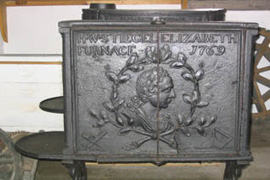 |
| This a Stiegel-period stove plate known as the "Hero" plate. Some historians believe the face to be the likeness of |